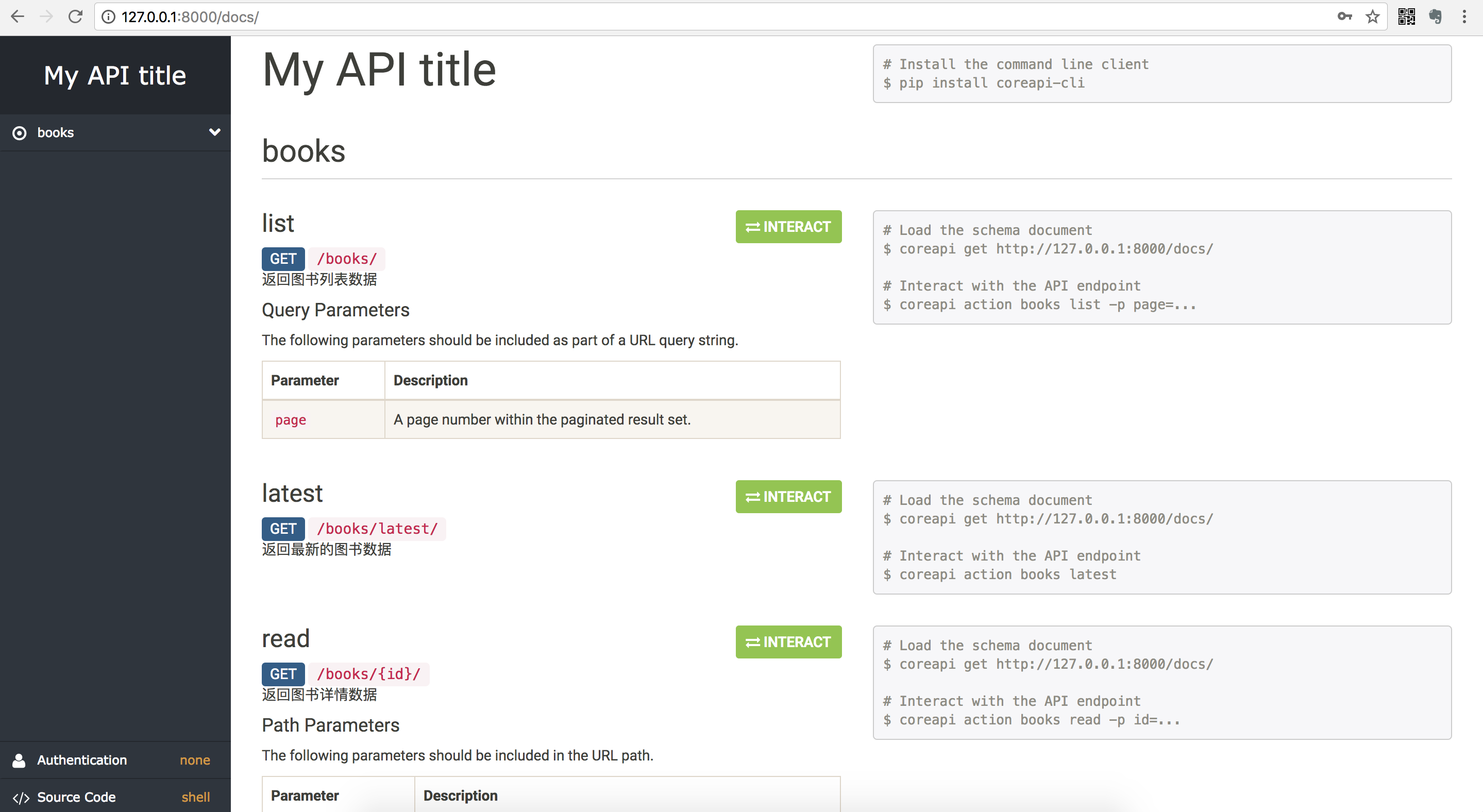DRF框架中常用的组件
为了方便接下来的学习,我们创建一个新的子应用 opt
python manage.py startapp opt
因为接下来的功能中需要使用到登陆功能,所以我们使用django内置admin站点并创建一个管理员.
python manage.py createsuperuser

创建管理员以后,访问admin站点,先修改站点的语言配置
settings.py
LANGUAGE_CODE = 'zh-hans'
TIME_ZONE = 'Asia/Shanghai'

访问admin 站点效果:

1. 认证Authentication
可以在配置文件中配置全局默认的认证方案
/home/moluo/.virtualenvs/drfdemo/lib/python3.6/site-packages/rest_framework/settings.py
# 可以在项目的主应用的settings.py配置文件中加入以下配置覆盖全局默认的配置方案。
REST_FRAMEWORK = {
'DEFAULT_AUTHENTICATION_CLASSES': (
'rest_framework.authentication.SessionAuthentication', # session认证
'rest_framework.authentication.BasicAuthentication', # 基本认证
)
}
也可以在每个视图中通过设置authentication_classess类属性来设置
from rest_framework.authentication import SessionAuthentication, BasicAuthentication
from rest_framework.views import APIView
class ExampleView(APIView):
# 类属性
authentication_classes = [SessionAuthentication, BasicAuthentication]
def get(self,request):
pass
认证失败会有两种可能的返回值,这个需要我们配合权限组件来使用:
- 401 Unauthorized 未认证
- 403 Permission Denied 权限被禁止
2. 权限Permissions
权限控制可以限制用户对于视图的访问和对于具体数据对象的访问。
- 在执行视图的as_view()方法的dispatch()方法前,会先进行视图访问权限的判断
- 在通过get_object()获取具体模型对象时,会进行模型对象访问权限的判断
提供的权限
- AllowAny 允许所有用户
- IsAuthenticated 仅通过登录认证的用户
- IsAdminUser 仅管理员用户
- IsAuthenticatedOrReadOnly 已经登陆认证的用户可以对数据进行增删改操作,没有登陆认证的只能查看数据。
配置使用
可以在配置文件中全局设置默认的权限管理类,如
REST_FRAMEWORK = {
....
'DEFAULT_PERMISSION_CLASSES': (
'rest_framework.permissions.IsAuthenticated',
)
}
如果未指明,则采用如下默认配置
'DEFAULT_PERMISSION_CLASSES': (
'rest_framework.permissions.AllowAny',
)
也可以在具体的视图中通过permission_classes属性来设置,如
from rest_framework.permissions import IsAuthenticated
from rest_framework.views import APIView
class ExampleView(APIView):
permission_classes = (IsAuthenticated,)
...
举例
from rest_framework.authentication import SessionAuthentication
from rest_framework.permissions import IsAuthenticated
from rest_framework.generics import RetrieveAPIView
class StudentAPIView(RetrieveAPIView):
queryset = Student.objects.all()
serializer_class = StudentSerializer
authentication_classes = [SessionAuthentication]
permission_classes = [IsAuthenticated]
自定义权限
如需自定义权限,需继承rest_framework.permissions.BasePermission父类,并实现以下两个任何一个方法或全部
-
.has_permission(self, request, view)是否可以访问视图, view表示当前视图对象
-
.has_object_permission(self, request, view, obj)是否可以访问数据对象, view表示当前视图, obj为模型数据对象
例如:
在当前子应用下,创建一个权限文件permissions.py中声明自定义权限类:
from rest_framework.permissions import BasePermission
class IsXiaoMingPermission(BasePermission):
def has_permission(self, request, view):
if request.user and request.user.username == "xiaoming":
return True
from .permissions import IsXiaoMingPermission
class StudentViewSet(ModelViewSet):
queryset = Student.objects.all()
serializer_class = StudentSerializer
permission_classes = [IsXiaoMingPermission]
3. 限流Throttling
可以对接口访问的频次进行限制,以减轻服务器压力,或者实现特定的业务。
一般用于付费购买次数,投票等场景使用.
可选限流类
1) AnonRateThrottle
限制所有匿名未认证用户,使用IP区分用户。
使用DEFAULT_THROTTLE_RATES['anon'] 来设置频次
2)UserRateThrottle
限制认证用户,使用User id 来区分。
使用DEFAULT_THROTTLE_RATES['user'] 来设置频次
3)ScopedRateThrottle
限制用户对于每个视图的访问频次,使用ip或user id。
例如:
class ContactListView(APIView):
throttle_scope = 'contacts'
...
class ContactDetailView(APIView):
throttle_scope = 'contacts'
...
class UploadView(APIView):
throttle_scope = 'uploads'
...
REST_FRAMEWORK = {
'DEFAULT_THROTTLE_CLASSES': (
'rest_framework.throttling.ScopedRateThrottle',
),
'DEFAULT_THROTTLE_RATES': {
'contacts': '1000/day',
'uploads': '20/day'
}
}
使用
可以在配置文件中,使用DEFAULT_THROTTLE_CLASSES 和 DEFAULT_THROTTLE_RATES进行全局配置,
REST_FRAMEWORK = {
'DEFAULT_THROTTLE_CLASSES': ( # 启用的限制类
'rest_framework.throttling.AnonRateThrottle',
'rest_framework.throttling.UserRateThrottle'
),
'DEFAULT_THROTTLE_RATES': { # 限制频率
'anon': '100/day',
'user': '1000/day'
}
}
DEFAULT_THROTTLE_RATES 可以使用 second, minute, hour 或day来指明周期。
也可以在具体视图中通过throttle_classess属性来配置,如
from rest_framework.throttling import UserRateThrottle
from rest_framework.views import APIView
class ExampleView(APIView):
throttle_classes = (UserRateThrottle,)
...
实例
全局配置中设置访问频率,settings.py代码:
REST_FRAMEWORK = {
# 权限[全局配置,会被局部配置覆盖]
# 'DEFAULT_PERMISSION_CLASSES': (
# 'rest_framework.permissions.IsAuthenticated',
# ),
# 限流
# 'DEFAULT_THROTTLE_CLASSES': ( # 全局启用的限制类
# 'rest_framework.throttling.AnonRateThrottle', # 匿名用户,游客
# 'rest_framework.throttling.UserRateThrottle' # 登录用户
# ),
'DEFAULT_THROTTLE_RATES': { # 限制频率
'anon': '3/minute',
'user': '10/minute',
'access': '5/minute', # 这个是自定义限流的频率配置
}
}
视图代码:
from students.models import Student
from students.serializers import StudentModelSerializer
from rest_framework.viewsets import ModelViewSet
from rest_framework.permissions import AllowAny,IsAuthenticated,IsAuthenticatedOrReadOnly,IsAdminUser
from .permission import ISMingGe
from rest_framework.throttling import UserRateThrottle,AnonRateThrottle,ScopedRateThrottle
class Students8APIView(ModelViewSet):
serializer_class = StudentModelSerializer
queryset = Student.objects.all()
# 权限配置
permission_classes = [AllowAny]
# 限流配置
# throttle_classes = [AnonRateThrottle,UserRateThrottle]
# 自定义限流配置
throttle_classes = [ScopedRateThrottle]
throttle_scope = 'access'
4. 过滤Filtering
对于列表数据可能需要根据字段进行过滤,我们可以通过添加django-fitlter扩展来增强支持。
pip install django-filter
在配置文件中增加过滤后端的设置:
INSTALLED_APPS = [
...
'django_filters', # 需要注册应用,
]
REST_FRAMEWORK = {
...
# 全局配置,也可以使用局部配置
'DEFAULT_FILTER_BACKENDS': ('django_filters.rest_framework.DjangoFilterBackend',)
}
在视图类中添加类属性filter_fields,指定可以过滤的字段
class StudentListView(ListAPIView):
queryset = Student.objects.all()
serializer_class = StudentSerializer
filter_fields = ('age', 'sex')
# 127.0.0.1:8000/opt/students/?sex=true #单个过滤条件
# http://127.0.0.1:8000/opt/students/?sex=false&age=27 # 多个并列的过滤条件
5. 排序
对于列表数据,REST framework提供了OrderingFilter过滤器来帮助我们快速指明数据按照指定字段进行排序。
使用方法:
在类视图中设置filter_backends,使用rest_framework.filters.OrderingFilter过滤器,REST framework会在请求的查询字符串参数中检查是否包含了ordering参数,如果包含了ordering参数,则按照ordering参数指明的排序字段对数据集进行排序。
前端可以传递的ordering参数的可选字段值需要在ordering_fields中指明。
示例:
class StudentListView(ListAPIView):
queryset = Student.objects.all()
serializer_class = StudentModelSerializer
filter_backends = [OrderingFilter]
ordering_fields = ('id', 'age')
# 127.0.0.1:8000/books/?ordering=-age
# -id 表示针对id字段进行倒序排序
# id 表示针对id字段进行升序排序
如果需要在过滤以后再次进行排序,则需要两者同步。要么一起写在全局配置中,要么一起写在视图类中。
from rest_framework.generics import ListAPIView
from students.models import Student
from .serializers import StudentModelSerializer
from django_filters.rest_framework import DjangoFilterBackend
class Student3ListView(ListAPIView):
queryset = Student.objects.all()
serializer_class = StudentModelSerializer
filter_fields = ('age', 'sex')
# 因为排序配置和过滤配置使用同一个类属性,所以当视图中需要使用排序和过滤时,
# 要么大家一起在视图类中局部配置,要么大家一起在全局中配置,否则会出现过滤组件使用无效的情况
# filter_backends = [DjangoFilterBackend,OrderingFilter]
ordering_fields = ('id', 'age')
配置文件:
# 过滤组件[全局引入]
# 'DEFAULT_FILTER_BACKENDS': ('django_filters.rest_framework.DjangoFilterBackend','rest_framework.filters.OrderingFilter')
6. 分页Pagination
REST framework提供了分页的支持。
我们可以在配置文件中设置全局的分页方式,如:
REST_FRAMEWORK = {
'DEFAULT_PAGINATION_CLASS': 'rest_framework.pagination.PageNumberPagination',
'PAGE_SIZE': 100 # 每页数目
}
如果在配置settings.py文件中, 设置了全局分页,那么在drf中凡是调用了ListModelMixin的list(),都会自动分页。
如果项目中出现大量需要分页的数据,只有少数部分的分页,则可以在少部分的视图类中关闭分页功能。
class 视图类(ListAPIView):
pagination_class = None
也可通过自定义Pagination类,来为视图添加不同分页行为。在视图中通过pagination_clas属性来指明。
class LargeResultsSetPagination(PageNumberPagination):
page_size = 1000
page_size_query_param = 'page_size'
max_page_size = 10000
class BookDetailView(RetrieveAPIView):
queryset = BookInfo.objects.all()
serializer_class = BookInfoSerializer
pagination_class = LargeResultsSetPagination
可选分页器
1) PageNumberPagination
前端访问网址形式:
GET http://127.0.0.1:8000/students/?page=4
可以在子类中定义的属性:
- page_size 每页数目
- page_query_param 前端发送的页数关键字名,默认为"page"
- page_size_query_param 前端发送的每页数目关键字名,默认为None
- max_page_size 前端最多能设置的每页数量
# 声明分页的配置类
from rest_framework.pagination import PageNumberPagination
class StandardPageNumberPagination(PageNumberPagination):
# 默认每一页显示的数据量
page_size = 2
# 允许客户端通过get参数来控制每一页的数据量
page_size_query_param = "size"
max_page_size = 10
# 自定义页码的参数名
page_query_param = "p"
class StudentAPIView(ListAPIView):
queryset = Student.objects.all()
serializer_class = StudentModelSerializer
pagination_class = StandardPageNumberPagination
# 127.0.0.1/four/students/?p=1&size=5
2)LimitOffsetPagination
前端访问网址形式:
GET http://127.0.0.1/four/students/?limit=100&offset=100
可以在子类中定义的属性:
- default_limit 默认限制,默认值与
PAGE_SIZE设置一直 - limit_query_param limit参数名,默认'limit'
- offset_query_param offset参数名,默认'offset'
- max_limit 最大limit限制,默认None
from rest_framework.pagination import LimitOffsetPagination
class StandardLimitOffsetPagination(LimitOffsetPagination):
# 默认每一页查询的数据量,类似上面的page_size
default_limit = 2
limit_query_param = "size"
offset_query_param = "start"
class StudentAPIView(ListAPIView):
queryset = Student.objects.all()
serializer_class = StudentModelSerializer
# 调用页码分页类
# pagination_class = StandardPageNumberPagination
# 调用查询偏移分页类
pagination_class = StandardLimitOffsetPagination
7. 异常处理 Exceptions
REST framework提供了自定义异常处理,我们可以自定义的方式来编写异常处理函数。例如我们想在要创建一个自定义异常函数,
这个函数,我们保存到当前主应用中[注意在实际工作中,我们可以设置一个单独的独立的公共目录来保存这种公共的函数/工具/类库]。
drfdemo/exceptions.py,代码;
from rest_framework.views import exception_handler as drf_exception_handler
from django.db import DatabaseError
from rest_framework.response import Response
from rest_framework import status
def custom_exception_handler(exc, context):
"""
自定义异常处理函数
:param exc: 异常对象,本次发生的异常对象
:param context: 字典,异常出现时的执行上下文环境
:return:
"""
# 先让drf进行异常判断
response = drf_exception_handler(exc, context)
# 判断response对象是否为None
if response is None:
"""出现drf不能处理的异常
当response结果为None时,则当前程序运行的结果有2种可能:
1. 出现drf不能处理的异常!
2. 程序报错了,但是drf框架不识别!
"""
if isinstance(exc, DatabaseError):
view = context.get("view")
print('数据库报错,[%s]: %s' % (view, exc))
return Response({"detail":"服务器内部错误!"}, status=status.HTTP_507_INSUFFICIENT_STORAGE)
if isinstance(exc, ZeroDivisionError):
view = context.get("view")
print("0不能作为除数! [%s]: %s" % (view, exc) )
return Response({"detail":"服务器内部错误!"}, status=status.HTTP_500_INTERNAL_SERVER_ERROR)
return response
在主应用的配置文件settings.py中声明自定义的异常处理
REST_FRAMEWORK = {
# 异常处理
'EXCEPTION_HANDLER': 'drfdemo.exceptions.custom_exception_handler',
}
如果未声明,会采用默认的方式,如下
rest_frame/settings.py
REST_FRAMEWORK = {
'EXCEPTION_HANDLER': 'rest_framework.views.exception_handler'
}
REST framework定义的异常
- APIException drf中所有异常的父类
- ParseError 解析错误
- AuthenticationFailed 认证失败
- NotAuthenticated 尚未认证
- PermissionDenied 权限受限
- NotFound 未找到
- MethodNotAllowed 请求方式不支持
- NotAcceptable 要获取的数据格式不支持
- Throttled 超过限流次数
- ValidationError 校验失败
也就是说,很多的没有在上面列出来的异常,就需要我们在自定义异常中自己处理了。
8. 自动生成接口文档
官方文档:http://core-api.github.io/python-client/
REST framework可以自动帮助我们生成接口文档。
接口文档以网页的方式呈现。
自动接口文档能生成的是继承自APIView及其子类的视图。
8.1. 安装依赖
REST framewrok生成接口文档需要coreapi库的支持。
pip install coreapi
8.2. 设置接口文档访问路径
在settings.py中配置接口文档。
REST_FRAMEWORK = {
# 。。。 其他选项
# 接口文档
'DEFAULT_SCHEMA_CLASS': 'rest_framework.schemas.AutoSchema',
}
在总路由中添加接口文档路径。
文档路由对应的视图配置为rest_framework.documentation.include_docs_urls,
参数title为接口文档网站的标题。
from rest_framework.documentation import include_docs_urls
urlpatterns = [
...
path('docs/', include_docs_urls(title='站点页面标题'))
]
8.3. 文档描述说明的定义位置
1) 单一方法的视图,可直接使用类视图的文档字符串,如
class BookListView(generics.ListAPIView):
"""
返回所有图书信息.
"""
2)包含多个方法的视图,在类视图的文档字符串中,分开方法定义,如
class BookListCreateView(generics.ListCreateAPIView):
"""
get:
返回所有图书信息.
post:
新建图书.
"""
3)对于视图集ViewSet,仍在类视图的文档字符串中封开定义,但是应使用action名称区分,如
class BookInfoViewSet(mixins.ListModelMixin, mixins.RetrieveModelMixin, GenericViewSet):
"""
list:
返回图书列表数据
retrieve:
返回图书详情数据
latest:
返回最新的图书数据
read:
修改图书的阅读量
"""
8.4. 访问接口文档网页
浏览器访问 127.0.0.1:8000/docs/,即可看到自动生成的接口文档。

两点说明:
1) 视图集ViewSet中的retrieve名称,在接口文档网站中叫做read
2)参数的Description需要在模型类或序列化器类的字段中以help_text选项定义,如:
class Student(models.Model):
...
age = models.IntegerField(default=0, verbose_name='年龄', help_text='年龄')
...
或
class StudentSerializer(serializers.ModelSerializer):
class Meta:
model = Student
fields = "__all__"
extra_kwargs = {
'age': {
'required': True,
'help_text': '年龄'
}
}